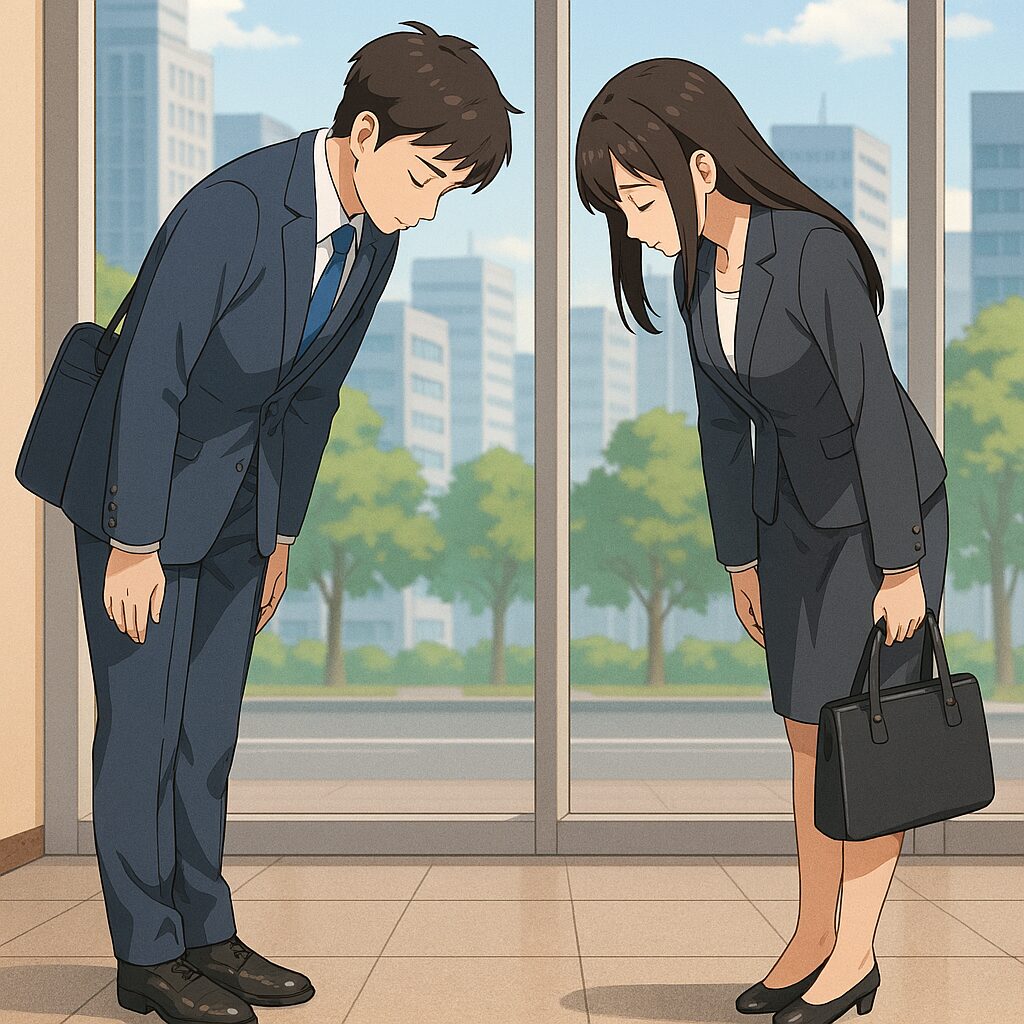One of the first things that surprises many visitors to Japan is how little physical contact occurs between people. No handshakes, no hugs—just a quiet bow. This bowing culture is far more than a social custom. It’s a deeply rooted practice shaped by ancient epidemic responses and a philosophy of expressing emotion through physical restraint.
In this article, we’ll explore why Japanese people avoid physical greetings like handshakes and hugs, and instead embrace the bow. From historical origins to cultural meaning, we’ll uncover the layers behind this elegant gesture.
- 🤲 A Country Without Handshakes or Hugs
- 🏯 Emperor Sūjin and the Origins of Non-Contact Etiquette
- 🧘♂️ The Philosophy of Bowing: Communicating Through the Body
- 🌏 Cultural Comparison: Is Avoiding Touch Cold?
- 🦠 Re-evaluating Non-Contact Etiquette During COVID-19
- 📜 The Future of Bowing Culture
- ✨ Conclusion: When Touch Is Absent, Heart Is Present
- 🤲 握手やハグがない国、日本
- 🏯 崇神天皇と疫病──触れない礼儀の起源
- 🧘♂️ お辞儀の哲学──身体を通じて心を伝える
- 🌏 海外との比較──触れないことは冷たいこと?
- 🦠 コロナ禍で再評価された「触れない礼儀」
- 📜 礼儀は進化する──未来のお辞儀文化
- ✨ まとめ──触れないからこそ、心が触れる
🤲 A Country Without Handshakes or Hugs
In many Western cultures, shaking hands is a standard greeting, and hugging is a sign of closeness. Physical contact is often seen as a way to build trust and intimacy.
In Japan, however, even close friends or family members rarely touch. Greetings are exchanged through bows, gratitude is expressed with bows, and apologies are offered with bows. This “respectful distance” isn’t just about shyness—it has historical roots.
🏯 Emperor Sūjin and the Origins of Non-Contact Etiquette
According to the Nihon Shoki (Chronicles of Japan), around 97 BCE during the reign of the 10th Emperor Sūjin, a devastating epidemic swept across the Japanese archipelago. It’s said that nearly half the population perished.
In response, Emperor Sūjin reformed religious rituals, established shrines, and offered sacred treasures to appease the gods. At the same time, people began changing their daily behaviors. To prevent the spread of disease, physical contact was minimized, and new forms of etiquette emerged.
Thus, the practice of “non-contact greetings” may have originated as a public health measure.
🧘♂️ The Philosophy of Bowing: Communicating Through the Body
Bowing is not just about lowering the head. It’s a physical expression of humility, respect, and emotional openness.
- Lowering oneself to show deference
- Opening the heart without words
- Conveying gratitude or apology silently
In this way, bowing becomes a form of communication that transcends language.
For a deeper look into the meaning of bowing, check out this article: 👉 Why Do Japanese People Bow?
🌏 Cultural Comparison: Is Avoiding Touch Cold?
To outsiders, Japan’s non-contact etiquette may seem distant or cold. But in reality, it’s the opposite. In Japanese culture, respecting personal space is a form of empathy, and avoiding touch is a gesture of trust.
In tea ceremonies, for example, hosts maintain a respectful distance and avoid unnecessary movement or speech. In Noh and Kabuki theater, performers use minimal motion, allowing silence and stillness to convey emotion.
This “aesthetics of silence” is explored further in this article: 👉 The Aesthetics of Silence: How Rei and Ma Shape Japan’s Wordless Communication
In Japanese culture, space and silence are not empty—they are full of meaning.
🦠 Re-evaluating Non-Contact Etiquette During COVID-19
Since 2020, the global pandemic has reshaped how people interact. Japan’s long-standing non-contact etiquette gained renewed appreciation.
- Avoiding handshakes and hugs reduced infection risk
- Wearing masks and maintaining distance came naturally
- Etiquette became a way to show care and consideration
Japan’s “touch-free manners,” cultivated over centuries, proved remarkably suited to the age of pandemics.
📜 The Future of Bowing Culture
As Japan continues to engage with the world, its etiquette may evolve.
- Handshakes and hugs may become more common in international settings
- Yet bowing will likely remain a symbol of Japanese identity
- Etiquette will continue to be a heartfelt expression of empathy and respect
✨ Conclusion: When Touch Is Absent, Heart Is Present
In Japan, the absence of handshakes and hugs is not a lack of warmth—it’s a different way of showing it. Rooted in ancient health practices, shaped by cultural philosophy, and refined through centuries of tradition, bowing is a gesture where the heart speaks through silence.
When touch is absent, the heart becomes more visible. That is the essence of Japanese etiquette.
なぜ日本では握手やハグではなく、お辞儀なのか?──疫病と礼節の深い関係
日本に初めて訪れた外国人が驚くことのひとつに、「人と人が触れ合わない」文化があります。挨拶の場面で、握手もハグもなく、静かに頭を下げる──それが日本流の礼儀。 この「お辞儀文化」は、単なる習慣ではありません。実は、古代から続く疫病対策の知恵と、身体を通じて心を伝える哲学が融合した、非常に奥深いものなのです。
今回は、日本人がなぜ握手やハグを避け、お辞儀を重んじるのか。その歴史的背景から文化的意味まで、じっくりと紐解いていきます。
🤲 握手やハグがない国、日本
欧米では、初対面の人と握手を交わし、親しい人とはハグをするのが一般的です。肌と肌を通じて信頼や親密さを表すこの習慣は、身体的接触を重視する文化の象徴とも言えます。
一方、日本では、たとえ親しい間柄でも、身体的接触は控えめ。挨拶はお辞儀、感謝もお辞儀、謝罪もお辞儀。 この「距離を保つ礼儀」は、単なるシャイさや内向性ではなく、歴史的な理由があるのです。
🏯 崇神天皇と疫病──触れない礼儀の起源
日本書紀によると、紀元前97年頃、第10代・崇神天皇の時代、日本列島に大規模な疫病が蔓延しました。人口の半数が亡くなったとも記されるこの災厄は、国家の存亡を揺るがすほどのものでした。
このとき、崇神天皇は神々の怒りを鎮めるために祭祀制度を整え、神社の創建や神宝の奉納を行いました。 同時に、人々の生活様式にも変化が起こります。感染拡大を防ぐために、接触を避ける行動が広まり、礼儀の形も変化したと考えられています。
つまり、「触れない礼儀」は、疫病対策として生まれた可能性が高いのです。
🧘♂️ お辞儀の哲学──身体を通じて心を伝える
お辞儀は、ただ頭を下げるだけの行為ではありません。そこには、相手への敬意、謙虚さ、そして「自分を一歩引く」美学が込められています。
- 頭を下げることで、自分の立場を低くする
- 相手に対して心を開く
- 無言のまま、深い感謝や謝罪を伝える
このように、お辞儀は「言葉を超えたコミュニケーション手段」として、日本文化の根幹を支えています。
さらに詳しく知りたい方は、こちらの記事もぜひご覧ください: 👉 なぜ日本人はお辞儀をするのか?
🌏 海外との比較──触れないことは冷たいこと?
海外の方から見ると、日本人の「触れない礼儀」は冷たく感じられるかもしれません。しかし、実際にはその逆。 日本では、相手の領域を尊重することが「思いやり」であり、「触れないこと」が信頼の証でもあるのです。
たとえば、茶道では客人との距離感を大切にし、無駄な動きや言葉を避けます。 能や歌舞伎でも、身体の動きは最小限に抑えられ、沈黙の中に感情が込められます。
この「沈黙の美学」については、こちらの記事でさらに深く掘り下げています: 👉 The Aesthetics of Silence: How Rei and Ma Shape Japan’s Wordless Communication
つまり、日本文化では「余白」や「間(ま)」が重要視され、そこにこそ心が宿るのです。
🦠 コロナ禍で再評価された「触れない礼儀」
2020年以降、世界中が新型コロナウイルスの脅威にさらされました。 このとき、日本の「触れない礼儀」が再評価されました。
- 握手やハグを避けることで感染リスクを減らす
- マスク着用や距離を保つことが自然にできる
- 礼儀を通じて、相手への配慮を示す
日本人が長年培ってきた「非接触の礼儀」は、現代のパンデミック時代において、非常に理にかなった行動様式だったのです。
📜 礼儀は進化する──未来のお辞儀文化
今後、日本の礼儀文化はどう進化していくのでしょうか?
- 海外との交流が増える中で、握手やハグを取り入れる場面も増えるかもしれません
- しかし、お辞儀という「心を込めた非接触の挨拶」は、今後も日本らしさとして残り続けるでしょう
- そして、礼儀は単なる形式ではなく、「相手を思いやる心の表現」として、より深く進化していくはずです
✨ まとめ──触れないからこそ、心が触れる
日本では、握手やハグをしない代わりに、お辞儀という静かな礼儀が根付いています。 その背景には、古代の疫病対策、身体を通じた哲学、そして相手への深い思いやりがあります。
触れないからこそ、心が触れる──それが、日本の礼儀文化の本質なのです。



コメント